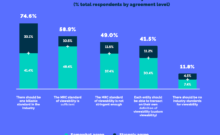The digital media industry’s latest obsessions are brand safety and viewability. Two closely linked topics born out of the controversial practice of programmatic advertising. Programmatic does serve certain purposes but more often than not it’s about trying to get inventory at the lowest possible rate, without actually knowing exactly where your ads are going. (Not knowing where your ads are going … bizarre isn’t it? Especially when some of the players involved claim to be location experts , but that’s the digital world we live in.)
Programmatic media buys will typically target certain categories and buy inventory at the cheapest rate in a blind auction. This results in ad placements that are hidden below the fold at best, or behind other ad units at worst. Some of these ads are never seen by actual people but have achieved decent click through rates. The fact that ads that can’t be seen are still being clicked exposed the problem of fake clicks and ad fraud and this has all led to the concept of viewability.
Yes, it’s a murky space and many CMOs have rightly called on their agencies to closely look at any programmatic buying. The simple rule for marketers should be, if a media owner can’t show you where your campaign is going to be live (for even a single impression), because they don’t know where it is, then don’t buy it.
Closely linked to viewability is the topic of brand safety. Marketers who are buying ads in blind networks have come to the rude awakening that sometimes these blind networks end up placing their ads exactly where they don’t want them to be. Next to terrorist communication or porn for example. While this is often amusing for the objective viewer, the brand damage can be massive.
Read More at The Original Article: www.bizcommunity.com









